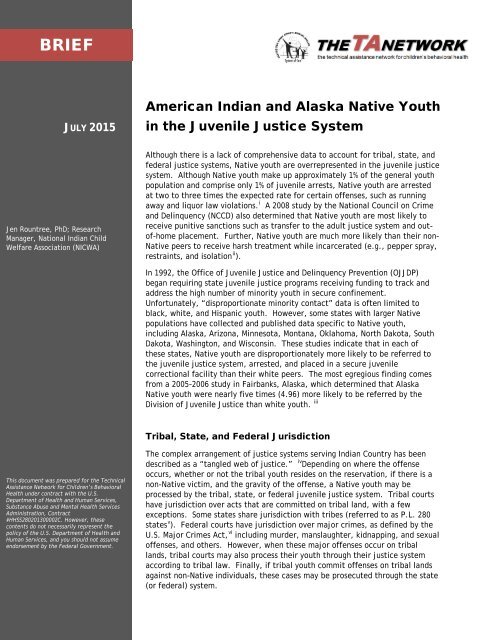Native American Youth In The Juvenile Justice System
Native American Youth In The Juvenile Justice System
Native American Youth In The Juvenile Justice System
Create successful ePaper yourself
Turn your PDF publications into a flip-book with our unique Google optimized e-Paper software.
BRIEF<br />
JULY 2015<br />
<strong>American</strong> <strong>In</strong>dian and Alaska <strong>Native</strong> <strong>Youth</strong><br />
in the <strong>Juvenile</strong> <strong>Justice</strong> <strong>System</strong><br />
Jen Rountree, PhD; Research<br />
Manager, National <strong>In</strong>dian Child<br />
Welfare Association (NICWA)<br />
Although there is a lack of comprehensive data to account for tribal, state, and<br />
federal justice systems, <strong>Native</strong> youth are overrepresented in the juvenile justice<br />
system. Although <strong>Native</strong> youth make up approximately 1% of the general youth<br />
population and comprise only 1% of juvenile arrests, <strong>Native</strong> youth are arrested<br />
at two to three times the expected rate for certain offenses, such as running<br />
away and liquor law violations. i A 2008 study by the National Council on Crime<br />
and Delinquency (NCCD) also determined that <strong>Native</strong> youth are most likely to<br />
receive punitive sanctions such as transfer to the adult justice system and outof-home<br />
placement. Further, <strong>Native</strong> youth are much more likely than their non-<br />
<strong>Native</strong> peers to receive harsh treatment while incarcerated (e.g., pepper spray,<br />
restraints, and isolation ii ).<br />
<strong>In</strong> 1992, the Office of <strong>Juvenile</strong> <strong>Justice</strong> and Delinquency Prevention (OJJDP)<br />
began requiring state juvenile justice programs receiving funding to track and<br />
address the high number of minority youth in secure confinement.<br />
Unfortunately, “disproportionate minority contact” data is often limited to<br />
black, white, and Hispanic youth. However, some states with larger <strong>Native</strong><br />
populations have collected and published data specific to <strong>Native</strong> youth,<br />
including Alaska, Arizona, Minnesota, Montana, Oklahoma, North Dakota, South<br />
Dakota, Washington, and Wisconsin. <strong>The</strong>se studies indicate that in each of<br />
these states, <strong>Native</strong> youth are disproportionately more likely to be referred to<br />
the juvenile justice system, arrested, and placed in a secure juvenile<br />
correctional facility than their white peers. <strong>The</strong> most egregious finding comes<br />
from a 2005–2006 study in Fairbanks, Alaska, which determined that Alaska<br />
<strong>Native</strong> youth were nearly five times (4.96) more likely to be referred by the<br />
Division of <strong>Juvenile</strong> <strong>Justice</strong> than white youth. iii<br />
Tribal, State, and Federal Jurisdiction<br />
This document was prepared for the Technical<br />
Assistance Network for Children’s Behavioral<br />
Health under contract with the U.S.<br />
Department of Health and Human Services,<br />
Substance Abuse and Mental Health Services<br />
Administration, Contract<br />
#HHSS280201300002C. However, these<br />
contents do not necessarily represent the<br />
policy of the U.S. Department of Health and<br />
Human Services, and you should not assume<br />
endorsement by the Federal Government.<br />
<strong>The</strong> complex arrangement of justice systems serving <strong>In</strong>dian Country has been<br />
described as a “tangled web of justice.” iv Depending on where the offense<br />
occurs, whether or not the tribal youth resides on the reservation, if there is a<br />
non-<strong>Native</strong> victim, and the gravity of the offense, a <strong>Native</strong> youth may be<br />
processed by the tribal, state, or federal juvenile justice system. Tribal courts<br />
have jurisdiction over acts that are committed on tribal land, with a few<br />
exceptions. Some states share jurisdiction with tribes (referred to as P.L. 280<br />
states v ). Federal courts have jurisdiction over major crimes, as defined by the<br />
U.S. Major Crimes Act, vi including murder, manslaughter, kidnapping, and sexual<br />
offenses, and others. However, when these major offenses occur on tribal<br />
lands, tribal courts may also process their youth through their justice system<br />
according to tribal law. Finally, if tribal youth commit offenses on tribal lands<br />
against non-<strong>Native</strong> individuals, these cases may be prosecuted through the state<br />
(or federal) system.

















